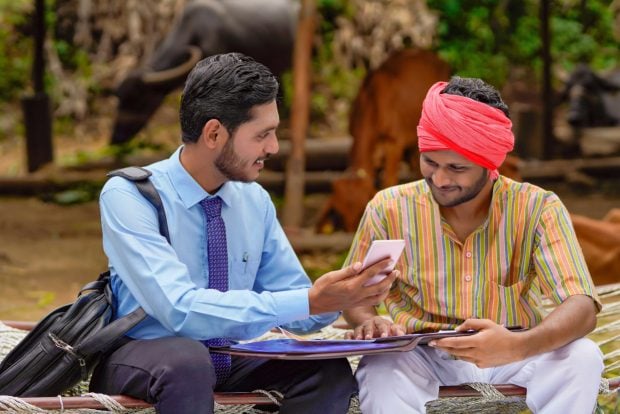Fintech in developing economies: paving the way for women’s financial inclusion

Driven by a surge of digital payments due to the pandemic, financial inclusion has increased all over the world. Yet, women are still more likely to be ‘unbanked’ than men. At a Global Government Fintech webinar, experts discussed how fintech can help female financial inclusion in the developing world and what numerous obstacles remain
The Covid-19 pandemic has led to a substantial increase in digital payments amid a global expansion of formal financial services, creating new economic opportunities as well as narrowing the gender gap in bank account ownership.
Two-thirds of adults worldwide have now made or received a digital payment, and the share in developing economies has grown to 57%, up from 35% in 2014, according to the World Bank’s latest Global Findex report.
As of 2021, 76% of adults globally have an account with a bank, other financial institution or with a mobile money provider – an increase from 68% in 2017 and 51% in 2011. In developing economies, account ownership stands at 71%, up from 63% in 2017 and 42% in 2011.
Account ownership may be on the up, but the majority of unbanked adults continue to be women no matter where they are in the world. The World Bank report found that about 740 million women do not have an account at a financial institution or through a mobile money provider.
The report did however show that the gender gap in account ownership narrowed globally from seven percentage points in 2017 to four percentage points in 2021, and from nine to six percentage points in low- and middle-income countries over the same period. These developments were discussed during a webinar – ‘How can fintech help women’s financial inclusion in the developing world?’ – organised by Global Government Fintech, the sister title of Global Government Forum on 5 July.
Unequal advancements
Maria Perdomo, regional co-ordinator for Asia at the United Nations Capital Development Fund (UNCDF), said that despite the gender gap shrinking globally, advancements in financial inclusion have not been equal in all countries. In countries such as Benin the gender gap has actually increased and in Bangladesh it remains close to 20%. “We still have a long way to go,” she said.
According to the World Bank, 40 million women still receive cash payments and digitising government-to-person (G2P) payments therefore represents what Perdomo described a “huge opportunity”.
Governments in countries such as Cambodia, Laos and Bangladesh could have provided social protection payments to thousands of workers in the female-dominated garment sector, Perdomo said. “The problem is that of the majority of these countries, very few governments actually had the capacity to leverage basic digital rails that existed before the pandemic and speed up the pace at which these payments were done and digitise them.”

Perdomo listed several obstacles that exacerbate this issue, such as the lack of national digital IDs, a lack of interoperability and low phone ownership particularly among women. According to the Mobile Gender Gap Report 2022, produced by industry association GSMA, the gender gap in smartphone ownership in low- and middle-income countries dropped from 21% in 2019 to 16 per cent in 2020, but then rose to 18% in 2021. And in Bangladesh for example, the gender gap in this area is 25%.
Perdomo also spoke of digital marketplaces such as Alibaba and its Southeast Asian arm Lazada. “Right after the pandemic started, we started to see a lot of innovations from these super-platforms that started selling products from MSMEs [micro, small and medium enterprises],” she said. “But such innovations are only happening in more developed countries while leaving others like Nepal, Bangladesh and Myanmar behind.”
Research has shown that women prefer to sell their products in more informal communities. “The problem is that these informal online communities don’t have digital payment systems built in that could be used to build more innovations and services,” Perdomo said.
While she acknowledged that fintech innovation has helped to narrow the gender gap in some countries, she emphasised how there was much left to do in the least developed countries specifically pointing to a lack of products that address the needs of women.
Four barriers to female financial inclusion
The International Monetary Fund (IMF) focuses on macroeconomic issues but in recent years gender issues have become a “mainstream topic” at the fund, said Rui Xu, an economist in the IMF’s Asia Pacific Department. “We have found that gender disparities have proven to be macro-critical and important for countries’ economic growth.”
The “remarkable” improvement of financial inclusion in sub-Saharan Africa can be attributed to fintech solutions such as mobile money, which is widely used in Africa, Xu said. However, research indicates overall progress is mostly limited to men, that women have less financial access and that they are less likely to use fintech solutions than men.
Looking to the drivers of this gender disparity, IMF research suggests four main barriers to women’s financial inclusion. The main reason for not having a bank account is a lack of money or regular income. The second driver is legal discrimination such as restrictions on a woman’s right to work or to hold properties. Thirdly, said Xu, women tend to have lower levels of education and financial literacy, which often means they are less aware of or more suspicious of fintech solutions. And lastly, mirroring Perdomo’s point, is the issue of low mobile phone ownership among women.

“The good news is that some new fintech solutions have already started tackling these barriers,” Xu said. For instance, access to mobile money has reduced poverty among female-headed households. “This is because a mobile money account provides a safe place for women to save money that previously their husbands may have had access to.” Another example are fintechs in India that are providing microfinance loans targeted at female entrepreneurs.
Like Perdomo, Xu also called for more female-oriented fintech solutions, and offered suggestions based on the IMF’s research. “Financial institutions could help by improving their credit database and promoting fintech solutions that are more tailored for women,” she said.
Improving female education would enhance women’s income and this in turn would improve financial access, Xu continued, adding that improving awareness in general is a key issue when promoting new fintech solutions. “Sometimes women are just not aware of the latest fintech solutions, because maybe due to their family division of labour they will focus more on family of affairs.”
While hopes are high that fintech can enhance financial inclusion, progress has been mixed, Xu concluded. “Women’s financial access is especially challenging in the current high inflation environment. Just as high inflation tends to hurt the poor more than the rich: when central banks tighten credit policy, it tends to affect women’s financial access more than men’s.”
The devil’s in the detail
Hillary Miller-Wise, deputy director – financial services for the poor at the Bill & Melinda Gates Foundation, which financially supports the Global Findex, said that the latest data had delivered “fantastic” news of the decline of the gender gap. However, “there’s still obviously more work to be done and sometimes in this data, the devil is in the detail”.
Of the developing economies with a gender gap, 18 have seen a reduction, but the disparity has worsened in nine, Miller-Wise pointed out. “When looking at this variability, it’s very difficult to make any sort of normative statement around what the main drivers are. It’s so specific to the environment and to the market.” Access to mobile money accounts has, for instance, been “absolutely vital” to many sub-Saharan African countries, she said. “However, we’re not seeing the kind of usage numbers we would expect: men with an account are six percentage points more likely to use them than women with an account.” She described the gender gap in usage as a “major problem” that has remained “virtually unchanged” since 2014.
In terms of lessons to be derived from the Findex report, Miller-Wise emphasised the importance of access to documentation or a valid ID. “From a policy perspective, this is a huge barrier especially for women,” she said. “We need to understand that there are some markets where there is not a national ID and poor women have a disproportionately low level of access. Just getting the basic facility to qualify for an account is an important first step.”
Looking at product and distribution, the true total cost of account or financial product ownership for women needed to be focused on, Miller-Wise continued. “It’s not just the cash or the interest rate on the loan, it’s more expansive: it’s the time she has to travel, the time she’s not at work, how she manages her childcare.” Segmentation of female customers needed to improve too, she said. “We collectively as an industry need to be working with governments and the financial service providers to be able to generate much better data and insights on different segmentations of potential and existing women customers in order to serve them better.”
Mobile connectivity and data privacy
Since mobile phone access plays a significant role in financial inclusion, panellists were asked to what extent geographically remote places continue to suffer from a lack of coverage and who should be responsible for rectifying this. “Coverage in a market like Kenya is quite good on a relative basis,” said Miller-Wise. “However, you still have a gap in terms of financial inclusion overall and that partly has to do with the unit economics of serving very dispersed populations.”
In comparison, India has a much higher population density, which means a bigger market to work with and more transactions. “From a distribution perspective you have to think about how to provide cash-in cash-out [CICO] services in a rural market in a way that is profitable for the agent that’s doing it,” Miller-Wise said. CICO networks allow customers to exchange cash for e-money and vice versa.

Perdomo agreed that agents’ ‘last mile’ access to consumers should be incentivised. “The question is how we prove there’s a business case for mobile network operators to go to the last mile to build a digital ecosystem that is functional so that people can really use those services.”
On the question of responsibility, she suggested governments should find ways to help incentivise and that the challenges should be a shared responsibility between the public and private sector.
Answering a question of how to persuade women who do not use online tools of the value of digital innovation, Xu pointed to the issue of data privacy. Research has shown that women appear less willing to share personal data than men and worry more about their security when dealing with companies online. “To tackle this problem, we need to improve data privacy and regulate fintech firms in terms of how they share the user’s data,” she said.
“I think there are many different reasons why women might not be inclined to use online solutions,” Miller-Wise added. While the role of regulators in terms of data protection is “absolutely critical”, she stressed the importance of educating the female customer. “In Kenya you have a proliferation of digital lenders and everybody just signs the terms and conditions without reading them. Suddenly you’ve got all these people who didn’t understand the implications of things like scraping your contact information or contacting your friends and family.”
The webinar concluded with a discussion about the possibilities for financial inclusion enabled by central bank digital currencies (CBDCs). The response was mixed. Perdomo said she was sceptical of a retail CBDC, but that a wholesale CBDC might have potential in terms of cross-border payments. “If designed well, it could be a good tool and great opportunity to improve financial inclusion,” Xu added. “But it’s important that financial inclusion should be a key objective when designing the CBDC.”
Miller-Wise agreed that the case for a wholesale CBDC was a more logical one. “But the question remains whether it’s really going to address the major challenges that we have in being able to serve the poor with financial services.”
Overall, the panellists agreed that fintech solutions have already started tackling numerous barriers to financial inclusion. While the latest Findex data highlights several positive developments – particularly in narrowing the gender gap in account ownership – there is still much more work to be done. Further progress will rely on a multitude of factors such as education, internet connectivity, mobile phone penetration rates, digital IDs, regulation and the development of female-oriented solutions.
The Global Government Fintech webinar, ‘How can fintech help women’s financial inclusion in the developing world?‘ was held on 5 July. You can watch the 75-minute webinar via our dedicated event page.






















Qui aide une femme aide le pays ainsi que le monde entier. Les encourager de s’ouvrir au monde de l’internet, les apprendre à utiliser les outils technologiques, les informer et les associer aux décisions qui les concernent. C’est une meilleure façon de trouver une solutions à plusieurs obstacles au niveau social, économique, financière, politique et étucatif.
Les femmes sont les meilleures à gérer plusieurs situations délicates au même moment par ce qu’elles peuvent écouter et gérer plusieures parsonnes au même moment.